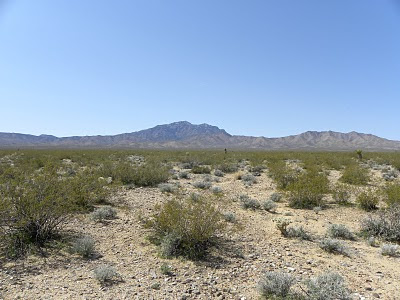The Department of Interior ordered BrightSource Energy LLC to temporarily halt construction on phases 2 and 3 of the Ivanpah Solar Energy Generating System since the project's impacts on the endangered desert tortoise have exceeded initial estimates. The 5.6 square mile project is being built on public land and was approved by the Department of Interior and California Energy Commission in October after a hasty environmental review process. Washington and Sacramento were intent on approving the project in time for BrightSource to qualify for taxpayer-backed financing.
 |
| Creosote bush scrub habitat in the Ivanpah Valley, with the Clark Mountains in the background. This photo was taken in March 2010, before construction began. |
During the environmental review last year, the Department of Interior estimated that the Ivanpah project would displace or kill 34 desert tortoises, which was still a phenomenally high number for a species that is in decline throughout its range and a testament to the pristine habitat targeted for destruction by the company. When BrightSource Energy bulldozed phase 1 and part of phase 2, however, the company displaced 49 tortoises, prompting the Department of Interior to revise its estimates.
As of late March, Interior announced that it now expected the project to displace or kill as many as 140 desert tortoises.
 |
| A captive tortoise foraging at BLM's Red Rock Canyon National Conservation Area visitor center. The US Fish and Wildlife Service assesses that the tortoise faces a difficult recovery based on current threats, including climate change and habitat destruction. |
Since BrightSource Energy's impacts on the desert tortoise clearly exceed initial estimates, the Department of Interior must now issue a revised biological opinion and reconsider the project's approvals. It's not clear if, or how soon Interior will give the project the green light again. According to the temporary suspension order, construction activities can continue in areas already bulldozed and cleared of tortoises, which includes phase 1 and a portion of phase 2. The rest of phase 2 and phase 3 must now be left untouched.
 |
| This photo by Erin Whitfield shows destruction of the Ivanpah Valley for phase 1 and part of phase 2 of BrightSource's project. This represents only a third of the total proposed project. |
Interior's suspension order comes a week after Google Inc. announced plans to invest $100 million in BrightSource's project. The company was quoted as saying that it saw the project as a "potentially transformative project" that is "good for the environment and a good business opportunity." Google is ironically ill-informed, investing in one of the most poorly planned renewable energy projects since the Glen Canyon Dam, paying to push the tortoise closer to extinction. The company's money would probably see a much quicker return if it were invested in
distributed solar generation (rooftop solar), or projects on
already-disturbed land.
 |
| Just a small portion of BrightSource's planned destruction in the Ivanpah Valley. |
The Ivanpah Valley is also being targeted for destruction by two projects proposed by
First Solar Inc--the Stateline and Silver State projects. If built, the two projects would bulldoze over 15 square miles of public land.
Advocates of giant solar projects claim that utility-scale solar generation is necessary to quickly cut greenhouse gas emissions. However, such facilities are expected to destroy nearly 334 square miles of pristine desert in America's southwestern public lands over the next 20 years, according to the Department of Interior, and this will only feed a fraction of our energy needs. The
Los Angeles Times took a position in the debate by calling for a smarter solar policy that encourages projects on already-disturbed and private lands.
Solar Done Right issued a report calling for more incentives for rooftop solar and, if necessary, projects on already-disturbed land. Germany added 3,000 MW of distributed generation in 2009 alone.
If we are serious about increasing renewable energy generation the right way, we will establish feed-in-tariffs and tax incentives that benefit individual citizens and small businesses that install rooftop solar systems instead of continuing to worship corporate giants that are more interested in profit than protecting the environment.






This comment has been removed by a blog administrator.
ReplyDeleteAn excellent post Shaun!
ReplyDeleteI am glad to hear that.
ReplyDeleteWish the injunction was not temporary.
These large scale solar utility projects need to be scrapped or perhaps built on already disturbed areas.
Nice post,
Bob